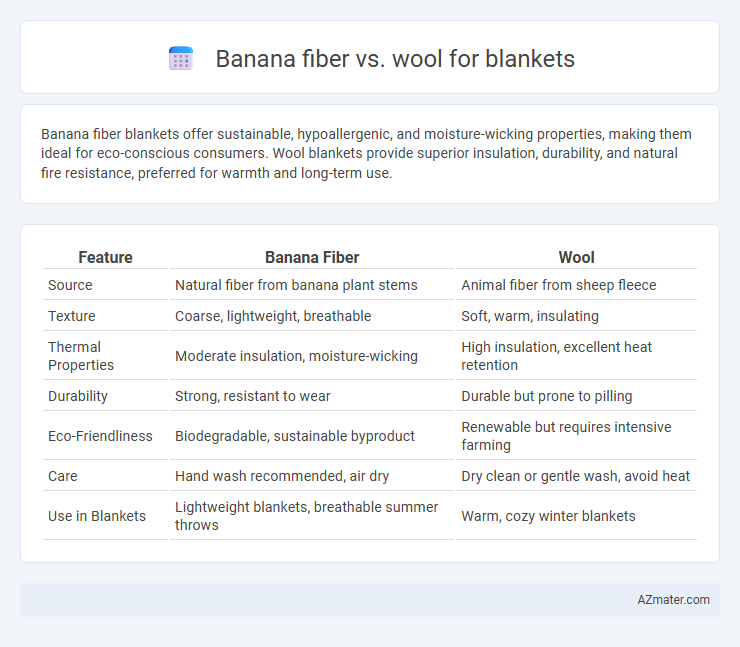Banana fiber blankets offer sustainable, hypoallergenic, and moisture-wicking properties, making them ideal for eco-conscious consumers. Wool blankets provide superior insulation, durability, and natural fire resistance, preferred for warmth and long-term use.
Table of Comparison
| Feature | Banana Fiber | Wool |
|---|---|---|
| Source | Natural fiber from banana plant stems | Animal fiber from sheep fleece |
| Texture | Coarse, lightweight, breathable | Soft, warm, insulating |
| Thermal Properties | Moderate insulation, moisture-wicking | High insulation, excellent heat retention |
| Durability | Strong, resistant to wear | Durable but prone to pilling |
| Eco-Friendliness | Biodegradable, sustainable byproduct | Renewable but requires intensive farming |
| Care | Hand wash recommended, air dry | Dry clean or gentle wash, avoid heat |
| Use in Blankets | Lightweight blankets, breathable summer throws | Warm, cozy winter blankets |
Introduction to Banana Fiber and Wool Blankets
Banana fiber blankets are crafted from natural fibers extracted from the banana plant's bark, offering a sustainable, biodegradable alternative known for its durability and moisture-wicking properties. Wool blankets, made from sheep's fleece, provide excellent insulation, breathability, and natural temperature regulation, renowned for warmth even in damp conditions. Both materials offer unique benefits, with banana fiber emphasizing eco-friendliness and wool emphasizing thermal comfort.
Sourcing and Sustainability of Materials
Banana fiber, sourced from the pseudostem of banana plants, is a highly sustainable material due to its utilization of agricultural waste and biodegradability. Wool is derived from sheep, requiring significant land, water, and feed resources, which raises concerns about environmental impact and animal welfare. Choosing banana fiber for blankets supports eco-friendly practices by reducing waste and minimizing resource consumption compared to the more resource-intensive wool production.
Production Process: Banana Fiber vs Wool
Banana fiber blankets are produced by extracting fibers from the pseudostem of banana plants through retting and mechanical scraping, followed by drying and spinning into yarn, emphasizing eco-friendly and sustainable methods. Wool blankets originate from shearing sheep, with fibers cleaned, carded, and spun into yarn through labor-intensive processes that require significant water and energy use. The banana fiber production process offers a renewable alternative with lower environmental impact compared to the traditional, animal-based wool production.
Texture and Softness Comparison
Banana fiber blankets offer a unique, slightly coarse texture that softens with use, providing a natural, breathable feel ideal for warmer climates. Wool blankets deliver a plush, dense softness with excellent insulation properties, making them perfect for cold weather comfort. While wool excels in long-lasting softness and warmth, banana fiber stands out for its eco-friendly, lightweight texture and moisture-wicking abilities.
Durability and Longevity
Banana fiber blankets exhibit exceptional durability due to their natural strength and resistance to wear, making them ideal for long-term use. Wool blankets also offer remarkable longevity, with fibers that self-repair and retain warmth over years of use. Both materials provide sustainable options, but banana fiber's tensile strength often surpasses wool in terms of abrasion resistance and moisture management.
Warmth and Insulation Properties
Banana fiber offers natural breathability and moisture-wicking properties, making it moderately warm but less insulating compared to wool. Wool provides superior warmth through excellent heat retention and high insulation, making it ideal for cold climates. The crimped structure of wool traps air efficiently, enhancing thermal insulation far beyond the comparatively lightweight banana fiber.
Breathability and Moisture Wicking
Banana fiber offers superior breathability compared to wool, allowing air to circulate more freely and keeping the skin cooler during sleep. Its natural moisture-wicking properties efficiently draw sweat away from the body, promoting a dry and comfortable sleeping environment. While wool is effective in moisture absorption, banana fiber excels in maintaining consistent airflow and rapid moisture evaporation, making it an optimal choice for warm climates and those seeking enhanced ventilation in blankets.
Allergy and Skin Sensitivity Factors
Banana fiber blankets offer excellent hypoallergenic properties, making them ideal for individuals with sensitive skin or allergies, as they resist dust mites and mold growth. Wool blankets, while warm and durable, can sometimes trigger allergic reactions or skin irritation due to lanolin content and coarse fibers. Choosing banana fiber minimizes the risk of itching and rashes, providing a softer, more breathable alternative for sensitive users.
Environmental Impact Assessment
Banana fiber blankets have a significantly lower environmental impact compared to wool blankets due to their biodegradable nature and the use of agricultural waste from banana plants, reducing deforestation and methane emissions associated with sheep farming. Wool production consumes substantial water and energy resources, while banana fiber cultivation requires minimal irrigation and pesticides, enhancing its sustainability profile. The carbon footprint of banana fiber blankets is markedly smaller, making them a more eco-friendly choice for environmentally conscious consumers.
Cost and Market Availability
Banana fiber blankets are generally more cost-effective than wool blankets due to lower raw material and production expenses, making them accessible for budget-conscious consumers. Wool blankets, often priced higher, benefit from established global supply chains and strong market presence, ensuring wide availability especially in colder regions. The growing interest in sustainable textiles is increasing demand for banana fiber, potentially affecting its future market distribution and pricing trends.

Infographic: Banana fiber vs Wool for Blanket
 azmater.com
azmater.com